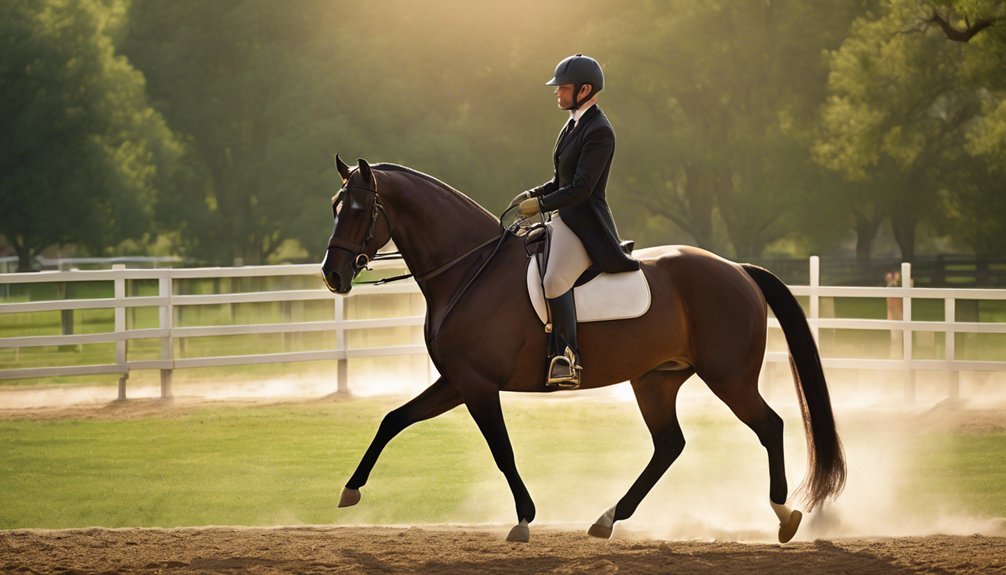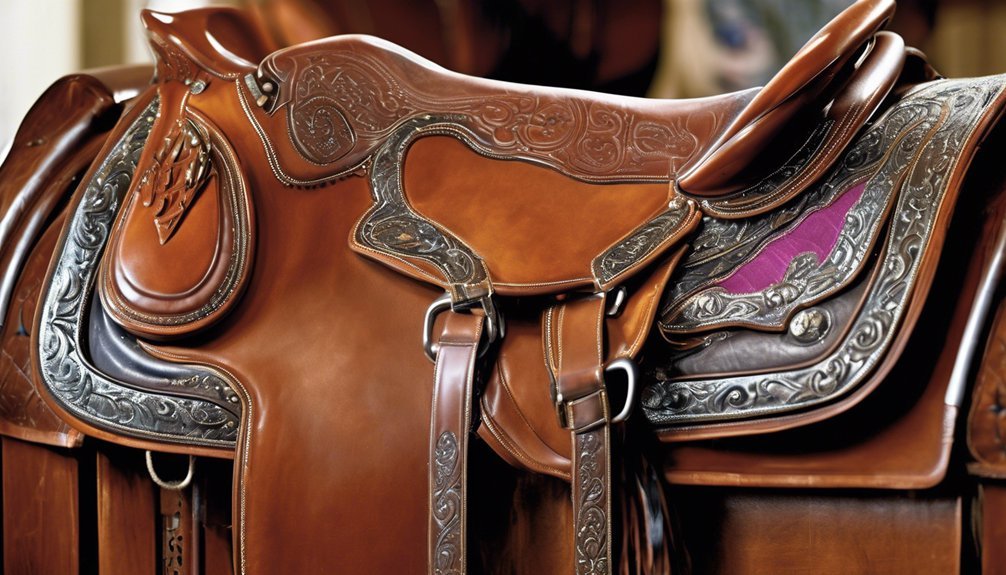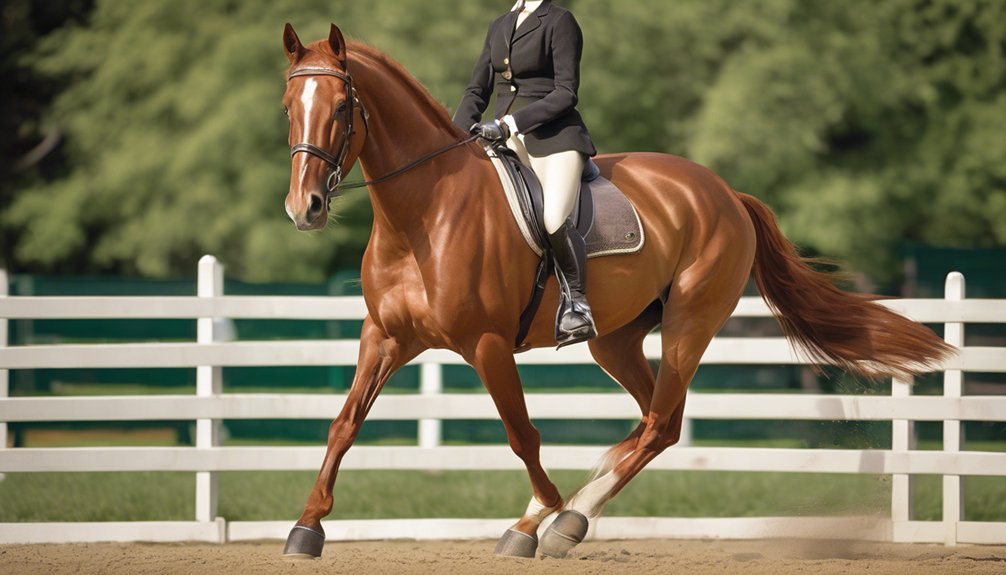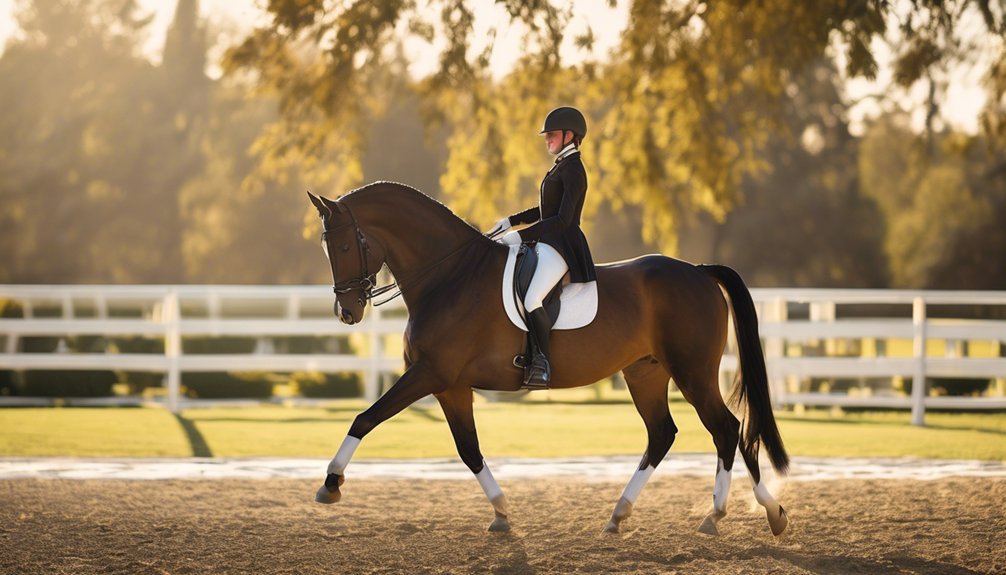
Did you know that your horse's responsiveness in dressage is often influenced by their body language just as much as your commands? Understanding this connection can significantly enhance your training experience. By establishing clear cues and fostering trust, you'll set the stage for improved communication. However, there's much more to consider when aiming for that seamless partnership in the arena. Let's explore some essential strategies to elevate your horse's performance.
Key Takeaways
- Establish clear and consistent cues using legs, hands, and voice to enhance communication and responsiveness during dressage training.
- Utilize positive reinforcement techniques, such as clicker training, to reward desired behaviors immediately and strengthen the connection.
- Recognize and respond to your horse's body language to create a supportive environment that fosters trust and comfort.
- Maintain consistent training routines with varied exercises to keep your horse engaged and adaptable to new challenges.
- Spend quality time building a strong bond with your horse, establishing trust as a foundation for improved responsiveness.
Understanding Equine Behavior
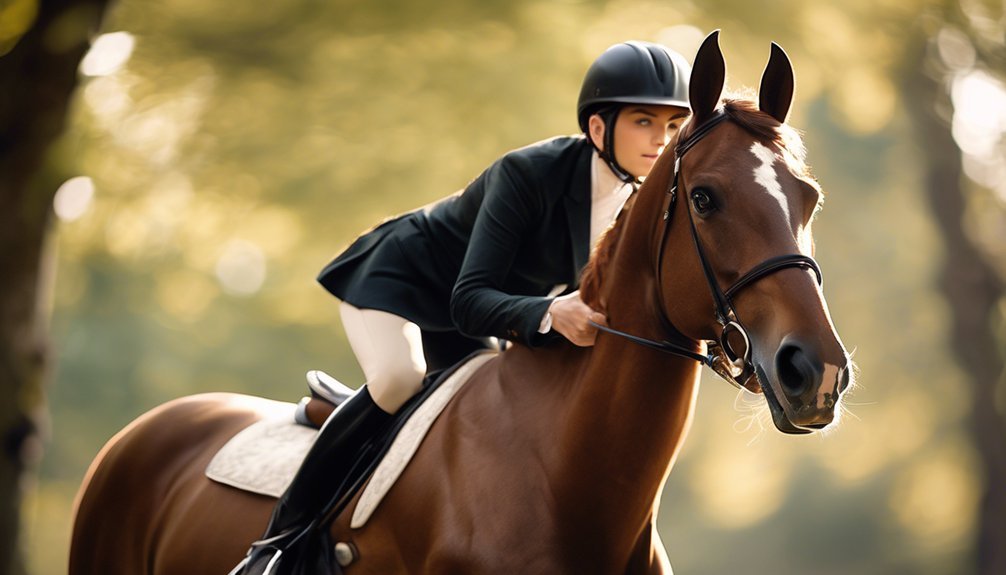
Understanding equine behavior is crucial for enhancing your horse's responsiveness. By diving into equine psychology, you'll uncover the intricate ways your horse communicates through behavioral cues.
Pay attention to their body language: ears, tail, and posture reveal their mood and intentions. For instance, a relaxed stance indicates comfort, while a tense body may signal anxiety. Recognizing these cues fosters a deeper bond between you and your horse, making your training more effective.
It's important to create a supportive environment where your horse feels safe to express itself. When you understand these behaviors, you'll not only improve responsiveness but also build a lasting connection rooted in trust and mutual respect.
Embrace this journey of understanding—your horse will thank you!
Establishing Clear Cues
Recognizing your horse's body language lays the foundation for establishing clear cues. When you observe their reactions to your signals, you can enhance cue clarity.
Start by using consistent aids—whether it's your legs, hands, or voice. Horses thrive on repetition, so make sure your signals remain the same each time. This builds their trust and understanding, reinforcing the bond between you both.
Always be mindful of your timing; delivering cues at the right moment is crucial for signal consistency. If your horse responds well, reward them immediately to create positive associations.
Building a Strong Foundation
Building a strong foundation for your horse's responsiveness starts with establishing a solid groundwork in trust and communication.
Creating this bond is essential for effective training. Here are four key steps to help you build that foundation:
- Establish Trust: Spend quality time with your horse, allowing them to get comfortable with you and your cues.
- Practice Balance Exercises: Incorporate exercises that promote your horse's balance, helping them feel secure and confident.
- Introduce Lateral Movements: Gradually introduce lateral movements, which enhance your horse's flexibility and responsiveness to your cues.
- Use Consistent Cues: Ensure your cues are clear and consistent, reinforcing understanding and trust in your communication.
Consistent Training Routines
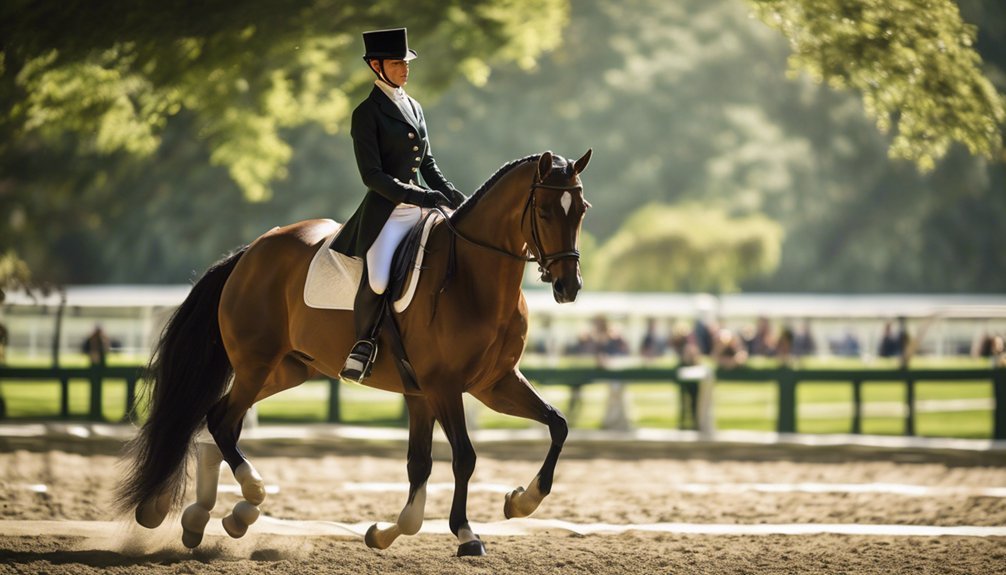
Consistent training routines are crucial for enhancing your horse's responsiveness, as they reinforce learned behaviors and establish a predictable environment. By maintaining a regular training frequency, you help your horse anticipate and understand what's expected. This consistency builds trust and confidence, making it easier for them to respond to your cues.
However, don't forget the importance of routine variety; mixing up exercises keeps your horse engaged and mentally stimulated. Incorporate different movements, transitions, and even new challenges to prevent monotony.
This balance between frequency and variety nurtures your horse's adaptability, ensuring they remain responsive during training and competitions. Remember, a well-structured routine cultivates a strong partnership, fostering a sense of belonging for both you and your horse.
Positive Reinforcement Techniques
Incorporating positive reinforcement techniques into your training routine can significantly boost your horse's responsiveness. By using methods like clicker training, you'll help your horse associate desired behaviors with rewards.
Here are some effective techniques to consider:
- Clicker Training: Use a clicker to signal correct behavior, followed by a treat.
- Immediate Reward Timing: Ensure you reward your horse instantly after they perform the desired action to strengthen the connection.
- Varied Rewards: Mix up treats, praise, and petting to keep your horse engaged and motivated.
- Consistency: Be consistent with your cues and rewards, allowing your horse to clearly understand what's expected.
These techniques foster a positive learning environment and enhance your bond with your horse.
Enhancing Your Communication Skills
How can you truly enhance your communication skills with your horse? Start by recognizing that effective communication involves both verbal cues and body language.
When you speak to your horse, use clear, consistent commands that they can easily understand. Pair these verbal cues with your body language—your posture, hand movements, and even your breathing can all convey messages.
For instance, shifting your weight can signal movement, while a relaxed stance promotes calmness. Observe your horse's reactions; they'll give you insight into what works and what doesn't.
Building this two-way communication fosters trust and connection, making your partnership stronger. Remember, the more you practice, the more responsive your horse will become in dressage, creating a harmonious bond between you both.
Incorporating Groundwork Exercises
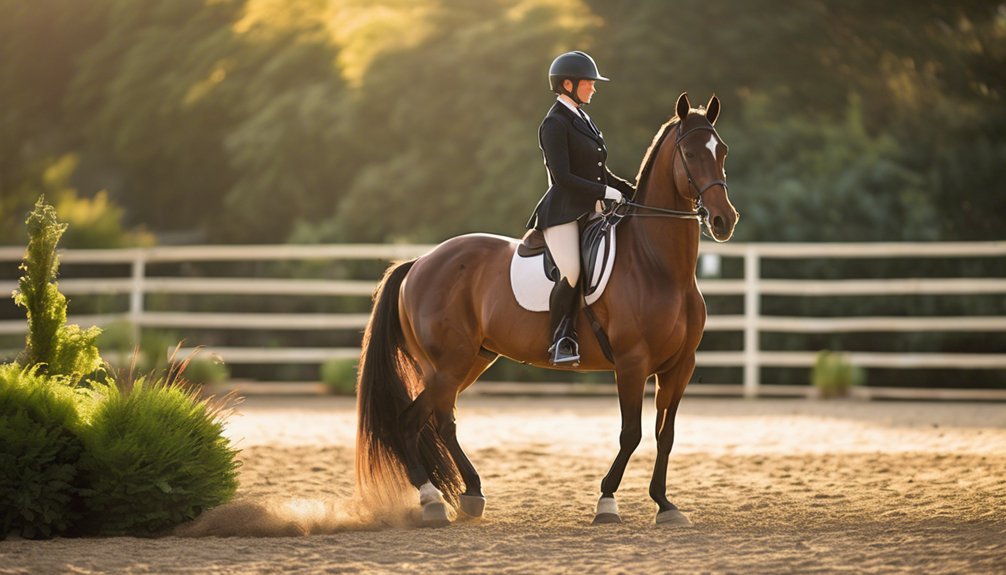
While you might think of groundwork as just a warm-up for riding, it serves as a vital foundation for enhancing your horse's responsiveness.
By incorporating specific exercises, you can unlock numerous groundwork benefits, particularly when it comes to lateral movements.
Here are four effective groundwork exercises to try:
- Lunging: Helps establish rhythm and balance, setting the stage for better control.
- Long-lining: Encourages your horse to respond to subtle cues, improving communication.
- Shoulder-in and haunches-in: Reinforces lateral movements and develops flexibility.
- Ground poles: Enhances coordination and encourages your horse to pay attention to their feet.
Integrating these exercises into your routine will strengthen your bond and elevate your horse's responsiveness during dressage.
Setting Realistic Goals
Setting realistic goals is essential for enhancing your horse's responsiveness, as it gives you both a clear direction and achievable benchmarks to strive for. When you engage in goal setting, consider breaking down your objectives into smaller, manageable tasks. This not only helps in tracking performance metrics but also boosts your motivation as you celebrate each milestone.
Here's a simple table to guide you:
| Goal Type | Example |
|---|---|
| Short-term Goal | Improve transitions |
| Medium-term Goal | Master a specific dressage test |
| Long-term Goal | Compete in a recognized event |
Evaluating Progress and Adjusting Techniques
To ensure your horse's responsiveness improves over time, regularly evaluating progress and adjusting your training techniques is crucial.
Here's how you can effectively conduct a progress assessment:
- Observe Behavior: Watch for changes in your horse's reactions and responsiveness during rides.
- Track Improvements: Keep a journal of specific exercises and note your horse's performance over time.
- Gather Feedback: Discuss your training with fellow riders or a coach to gain new perspectives on your techniques.
- Modify Techniques: If you notice stagnation, don't hesitate to implement technique modifications that align better with your horse's learning style.
Frequently Asked Questions
How Long Does It Take to See Improvements in Responsiveness?
You'll likely see improvements in responsiveness within a few weeks, depending on your training frequency and rider consistency. Regular practice builds trust and communication, so stay patient and committed to your horse's progress.
What Common Mistakes Should I Avoid During Training?
You'd think ignoring your horse's responses would work wonders, right? Avoid that mistake! Focus on clear communication cues and effective training techniques to foster understanding. Patience and consistency are your best allies in this journey.
Can Different Horse Breeds Affect Responsiveness?
Yes, different horse breeds can affect responsiveness. Breed characteristics influence temperament and learning styles, so adapting your training methods to suit your horse's unique traits will enhance connection and improve overall responsiveness during your sessions.
Should I Use a Specific Bit for Better Communication?
Using specific bit types can enhance your communication aids with your horse. Experimenting with different bits tailored to your horse's needs often leads to improved responsiveness, fostering a deeper connection and understanding between you both.
How Can I Tell if My Horse Is Stressed During Training?
When your horse isn't quite in their happy place during training, watch for stress signals like pinned ears, tail swishing, or tense muscles. A supportive training environment can help soothe their nerves and enhance overall performance.
Conclusion
Improving your horse's responsiveness in dressage isn't just a journey; it's a partnership. As you refine your cues and embrace positive reinforcement, you'll notice your horse becoming more in tune with you. Remember, every small victory is a step forward, and just like your horse, you'll learn and grow together. So, keep those training sessions varied and fun, and before you know it, you'll both be dancing through your routines with newfound confidence and connection.



